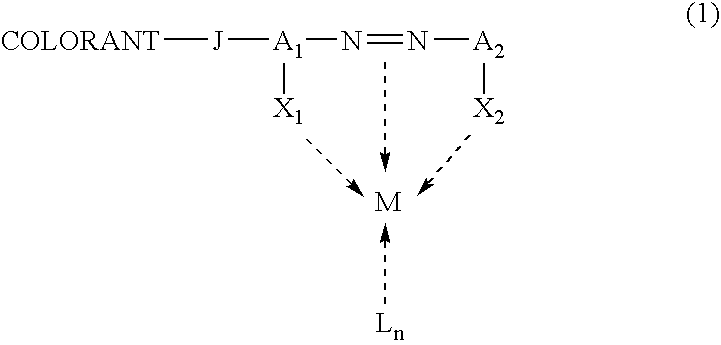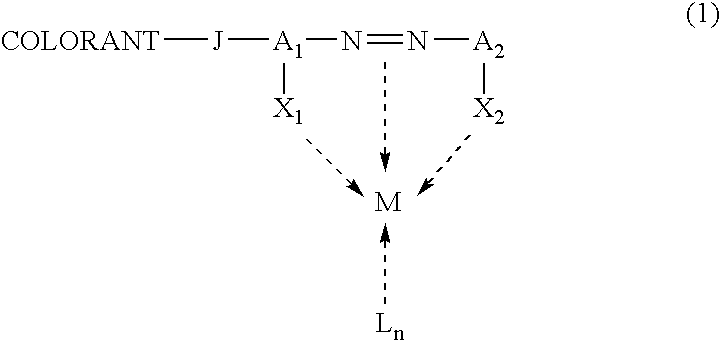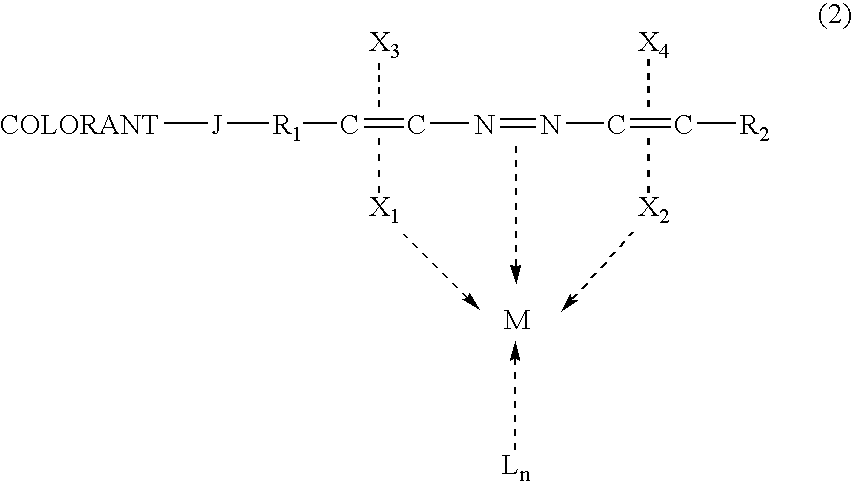Metal complex colorant comprising azo moiety
a technology of azo moiety and metal complex, which is applied in the direction of disazo dye, anthracene dye, dyeing process, etc., can solve the problems of limiting the types of colorants to which the method may be applied, and the dyes are not light/water resistan
- Summary
- Abstract
- Description
- Claims
- Application Information
AI Technical Summary
Benefits of technology
Problems solved by technology
Method used
Image
Examples
synthesis example 1
[0082] (1) 36.5 g of ACID RED 4 (E-SO3Na), 300 ml of DMSO (dimethylsulfoxide) and 31.5 g of an azo compound having formula 4 below were placed in a 500 ml Erlenmeyer flask and melted. One or two boiling chips were introduced into the flask and 30 ml of concentrated sulfuric acid was slowly added. Then, the flask was connected to a reflux cooler and the mixture was refluxed at 80° C. for at least 8 hours. Next, the mixture was cooled to room temperature and an excess of methanol was added to form crystals, and then the crystals were filtered through a suction filter. To remove unreacted reactants, the filtered crystals were dissolved again in DMSO, methanol was added to form crystals, and the crystals were filtered through a suction filter. The filtered crystals were dried in an oven to obtain a colorant having formula 5 below (42.6 g).
[0083] (2) 34.2 g of the colorant having formula 5 below obtained in (1) and 13 g of an aqueous ammonia solution (30%) were added to 400 ml of ethyle...
synthesis example 3
[0086] 41.3 g of DIRECT BLACK 51 (E-COOH), 300 ml of DMSO and 25.0 g of an azo compound having formula 8 below were placed in a 500 ml Erlenmeyer flask and melted. One or two boiling chips were introduced into the flask, and 30 ml of concentrated sulfuric acid was slowly added. Then, the flask was connected to a reflux cooler and the mixture was refluxed at 80° C. for at least 8 hours. Next, the mixture was cooled to room temperature, an excess of methanol was added to form crystals, and then the crystals were filtered through a suction filter. To remove unreacted reactants, the filtered crystals were dissolved again in DMSO, methanol was added to form crystals, and then the crystals were filtered through a suction filter. The filtered crystals were dried in an oven to obtain a colorant having formula 9 below (42.2 g).
[0087] 33.3 g of the colorant having formula below 9 obtained in (1) was dissolved in 150 ml of water and 10.7 g of CrCl3.6H2O was added. The resultant solution was r...
synthesis example 4
[0088] (1) A colorant having formula 10 below (54.3 g) was produced in the same manner as in Synthesis example 3 (1), except that 23.2 g of an azo compound having formula 6 was used instead of 25.0 g of an azo compound having formula 8 and 73.1 g of DIRECT BLACK 168 (E-OH) was used instead of 41.3 g of DIRECT BLACK 51 (E-COOH).
[0089] (2) 20 g of ammonia and then 6.8 g of CuCl2.2H2O were added to 500 ml of to and melted. 32.4 g of the colorant having formula 10 below obtained in (1) was added to the resultant solution and mixed while heating to 80° C., and then 35 g of ammonium chloride and 150 ml of hot water were added to the mixture. Then, NaCl was added to the mixture to form precipitates. Then, the precipitates were filtered and dried in an oven to obtain a metal complex colorant (27.5 g).
PUM
| Property | Measurement | Unit |
|---|---|---|
| pH | aaaaa | aaaaa |
| pH | aaaaa | aaaaa |
| temperature | aaaaa | aaaaa |
Abstract
Description
Claims
Application Information
 Login to View More
Login to View More - R&D
- Intellectual Property
- Life Sciences
- Materials
- Tech Scout
- Unparalleled Data Quality
- Higher Quality Content
- 60% Fewer Hallucinations
Browse by: Latest US Patents, China's latest patents, Technical Efficacy Thesaurus, Application Domain, Technology Topic, Popular Technical Reports.
© 2025 PatSnap. All rights reserved.Legal|Privacy policy|Modern Slavery Act Transparency Statement|Sitemap|About US| Contact US: help@patsnap.com



